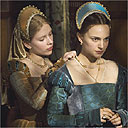
The year is 1525. The place? England. Comely young noblewomen, their cheeks prettily dimpling, are involved with steamy sexual intrigue and apparently favouring the kind of bodice that, like a stripper's policewoman costume, has velcro seams for ease of ripping.
This is the habitat for Justin Chadwick's flashy, silly, undeniably entertaining Tudor romp, in which a very buff Henry VIII, played by Eric Bana, finds himself much taken with the charms of Anne Boleyn, his second wife-to-be, played by Natalie Portman, and also Anne's babelicious younger sister Mary, played by Scarlett Johansson. But which of these had the chief claim on His Majesty's heart and other parts of his anatomy? Which, in fact, was the lesser rival, the "other" Boleyn girl?
It is absurd yet enjoyable, and playing fast and loose with English history is a refreshing alternative to slow and tight solemnity; the effect is genial, even mildly subversive. Peter Morgan's deadpan script is at its most startling when the strained Anne Boleyn, desperate for an heir, whispers to her sister her frantic need to cure her royal husband's impotence: "I have to resort to ever more degrading practices - he hates himself in the morning!"
I can almost see Kristin Scott Thomas, playing Anne's long-suffering mother, snapping: "And what degrading practice might this be, forsooth? If it be what I think it be, there is no surprise that thou art not with child, thou young fool; knowst thou not that avoiding getting with child is a minor but distinct advantage of yon degrading practice?"
Philippa Gregory wrote the 2001 novel on which this movie is based (there was also a BBC TV adaptation in 2003) and working from the historical fact of Mary Boleyn's status as the king's one-time mistress, she cleverly retrieved her from historical oblivion and set her on this counter-factual thrill-ride. Tudor history was cheekily reimagined as chick-lit sibling rivalry. That emotionally literate monarch King Henry here seduces the pliant Mary by sweetly murmuring that he understands how she is not used to people being nice to her: "Compliments in your family were for someone else; I, too, know what it is like to be the second child." Oh indeed, my liege, and men do say that women come from Venus, men from Mars ...
Mark Rylance plays the women's father, Sir Thomas Boleyn, and this actor's distinctive delivery - delicate, musical, introspective - nicely conveys an ambitious, yet weak-willed man out of his depth in court politics. Kristin Scott Thomas, like many of the womenfolk, is landed with wearing one of those pentagonal bonnets, and looks as if she is frowning out from the middle of a geometry problem. David Morrissey is that outrageously evil schemer the Duke of Norfolk, a virtual panto villain.
It is the Duke who solicits both Boleyn girls as possible royal mistresses, and before the tragedy of their royal careers begins, Mary and Anne are sweetly intimate, at one stage walking along beside a gurgling stream together in matching outfits apparently made from John Lewis curtains. Anne wears a pendant with a big letter B on it; for all I know, this might be taken directly from a portrait, but it makes her look like she's out for an evening at a disco in Watford, circa 1981. They are to find that King Henry is a complete and total hottie, not at all fat nor given to chucking chicken bones over his shoulder.
Competing for his favour is tragically to poison their sisterly love. Mary is browbeaten into Henry's bed, but he turns out (at this stage) to be a bit of a sensitive dreamboat beneath the duvet and when she emerges the next day, Chadwick indicates that the night has gone swimmingly by languorously showing a lovely sunrise. However, the mood is broken by David Morrissey's duke brutally demanding to know: "Well? Did he have you? More than once?"
The royal favour is, however, to turn capriciously to the bewitching Anne when pregnancy complications confine Mary to her sickbed, leaving the field free for her sister, lately returned from the French court, to prance and cavort and generally capture the king's heart. Politics and dysfunction and sexual jealousy are yoked together and Mary and Anne turn things into a classic blonde versus brunette face-off: Marilyn and Jackie at the Kennedy White House. This soapy story becomes, outrageously, more important than anything else: Henry's break with Rome is hardly more than a footnote or afterthought in the hissy-fit world of Tudor shagging. It is ridiculous, but imagined with humour and gusto: a very diverting gallop through the heritage landscape.

